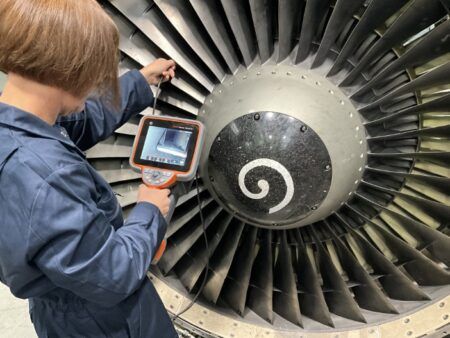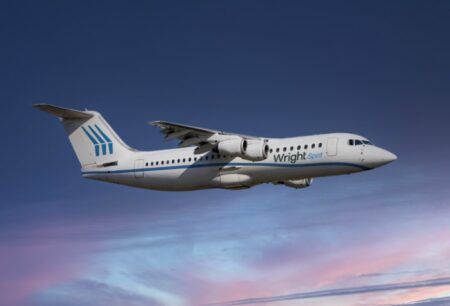When the wing of a Lockheed Martin C-130J Hercules failed in December 2015, it was a cause for celebration by scientists and engineers in the UK and Australia. The reason for the celebration was that the failure marked the conclusion of the physical testing phase of the international collaborative C-130J Hercules Wing Fatigue Test Programme (WFTP), conducted at Marshall Aerospace and Defence Group’s facility in Cambridge, UK.
The WFTP was designed to provide fatigue data under representative Royal Air Force and Royal Australian Air Force flight loads, to establish a structural life of type (SLOT) for the Hercules and optimize the safety by inspection regime under which the type currently operates.
WFTP genesis
The UK and Australia were early customers for the latest version of the Hercules, which entered production in the early 1950s, and both began introducing the new aircraft to service in the late 1990s.
Although Lockheed Martin, the original equipment manufacturer, had conducted C-130 structural and fatigue testing as part of its certification of earlier variants, the RAF considered that configuration differences introduced into the C-130J design warranted a new full-scale fatigue test program under representative load conditions.With similar concerns and a similar operational profile for its own C-130Js, the RAAF expressed an interest in the program and was subsequently invited to collaborate on a bilateral basis. The management arrangements were agreed and established in 2001.
Marshall Aerospace had long been a C-130 specialist and had conducted fatigue testing on the earlier C-130K variant for the RAF at its Cambridge facility, making it a natural choice for the latest testing activity.
Australia’s physical involvement with the WFTP began in 2003 and a large number of personnel worked within the program until physical testing ceased at the end of 2015.
“The test program was pursued to confirm critical structure, to determine the structural life of type of the C-130J wing and to generate data to support improved in-service management of critical wing structure,” says RAAF Group Captain Joe Medved, director of aviation engineering within Directorate General Technical Airworthiness – Australian Defence Force (DGTA-ADF).Personnel from Australia’s Defence, Science and Technology Organisation (DSTO, now Defence Science and Technology Group), DGTA-ADF and Air Lift Systems Programme Office (ALSPO) are involved, together with their counterparts in the UK, including the Defence Evaluation and Research Agency (DERA, now the Defence Science and Technology Laboratory) and QinetiQ.Over the tested period, which began in 2003 and runs until the end of 2016, a squadron leader engineer from the DGTA-Aircraft Structural Integrity (ASI) branch and a scientist from DSTO/DST Group is embedded with Marshalls to facilitate a successful outcome for the ADF.
Methodology
Because Marshall had previously carried out C-130K testing, much of the existing infrastructure was able to be repurposed, including the wing fatigue test rig.Prior to the beginning of testing, two RAF
C-130Js were fitted with a flight load monitoring system and gathered inflight load information during more than 750 flights.
“Accurately applying the complex maneuver and turbulence loads encountered was a significant undertaking and one that required considerable expertise and technical fidelity,” comments Robert Ogden, C-130J task leader with DST Group’s Airworthiness and Life Evaluation Section.”From those 750 or so flights, approximately 250 were selected as representative of RAF and RAAF flying and as a result represented the loads to be repetitively applied to the full-scale fatigue test.”
A new-build C-130J wing was purchased from Lockheed Martin for the purpose. However, because RAF and RAAF Hercules were built earlier and therefore had an earlier structural configuration, the test article required modification to bring it back to a representative standard.
Modified C-130K nacelle structures were fitted, to enable the application of representative gust and engine torque loads, and a representation of a section of fuselage around the wing-to-fuselage attach fittings was added, to allow simulation of additional loads caused during cabin pressurization and depressurization.
“Simulating these load distributions on the test article was achieved through the complex interaction of 40 hydraulic actuators on the wing and engine nacelles,” Ogden added.
Specifically, 24 actuators were attached to the wing section, 12 on each outer wing, mounted in pairs in order to apply shear, bending and torsion loads. Pressurization loads on the center wing section were simulated by four actuators (two fore and two aft) to apply lateral loads to the ‘fuselage’ sidewall, together with an airbag pushing upward on the center wing section.
Each of the four nacelle structures had three actuators connected, to apply engine torque loads as well as vertical and lateral gusts and inertia loads.
Testing milestones
The testing program had multiple complex phases and was marked by a number of milestones as the program progressed: from conception, the development of flight loads, the design of the test rig itself, development of test loads and the actual conduct of the test proper.
Testing was planned to verify the durability of the wing structure over 62,500 flight hours, representing two design lifetimes, and was followed by a residual strength test phase to ultimate failure, to demonstrate residual load carrying capability and, ideally, to experience catastrophic failure to inform SLOT determinations.
One of the early functions of DST Group was to provide a level of technical leadership on the program and it performed work on analysis of the flight load spectrum for RAF and RAAF C-130Js, including coupon testing and verification of Marshall’s testing system. It also set data capture requirements and verification of the accuracy and repeatability of the loadings to be applied to the test article. The organization also provided on-site technical representation, together with DGTA-ASI, between 2003 and late 2015.
Besides the small team embedded with Marshall Aerospace, a dedicated team at DST Group’s facility at Fishermans Bend in Melbourne supported the test program.
During the course of fatigue testing, damage was identified through routine inspection at a number of areas within the wing structure, most notably around the wing-to-fuselage interface. These locations were carefully monitored for damage progression as testing moved toward conclusion.
At the completion of 50,000 hours of testing, damage was artificially induced at a number of locations across the center and outer wing, with the aim of obtaining crack propagation data over the remaining 12,500 flight hours of testing to support optimization of the extant safety by inspection program. After successful completion of 62,500 hours of fatigue testing, static loads simulating 1.2 times the design limit load were applied to demonstrate the residual strength capability of the wing.
After multiple application of the residual strength loads, the test article catastrophically failed across the wing lower surface at the wing-to-fuselage interface. This is a known fatigue critical area and subject to inspection as part of the existing safety by inspection requirements. Squadron Leader Aaron Jozelich, an engineer with the RAAF’s ALSPO and the final liaison officer in the UK, explains: “We expected it to fail where it did and we were tracking multiple damage sites in that area for quite a number of hours before the eventual failure. “We expect we will be able to accurately trace failure progression through a sequence of events following teardown of the test article and we are quite happy with the outcome that we were able to achieve,” he adds.
Structural teardown and residual work
The wing test article is now being shipped to Australia, where it will be the subject of a detailed teardown inspection and analysis of damaged areas. Teardown work will be carried out at RAAF Richmond, west of Sydney, by Airbus Group Australia Pacific – the contracted maintenance provider for the RAAF C-130J fleet, together with DST Group and ALSPO.
Once the wing has been completely dismantled, specialized non-destructive inspection techniques will be applied to the structure to probe for critical fatigue cracks. Damaged components will then be sent to Fishermans Bend for fractographic analysis by DST Group scientists, who are world-renowned leaders in this field.
Fractographic analysis will enable crack growth rates to be established under known conditions, which will then be interpreted to actual RAAF usage to establish a SLOT and optimize the safety by inspection program.
The ultimate goal is to have results from the WFTP fully implemented into the RAAF C-130J Maintenance Programme by 2020 and this work will be undertaken by QinetiQ Australia, as an active partner in the completion of the activity.
The interpretation of results is being left to the individual partner nations, but the intellectual property resulting from the C-130J WFTP is jointly owned by the UK and Australia. Test data is also available to Lockheed Martin to support RAF and RAAF fleets and, subject to agreement by the RAF and RAAF, may also be used in the future by other C-130J users in support of their own individual fleets.
“It enables us to be an informed customer, and the sovereign capability allows us to bring aircraft into service that may have incomplete fatigue data and complete the necessary work here,” concludes Air Commodore James Hood, director general of technical airworthiness for the ADF.
“Structural integrity programs such as this give us a higher level of confidence and allow us to keep aircraft in service for a longer period of time.”




